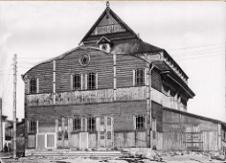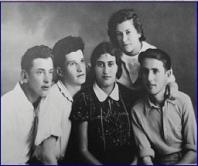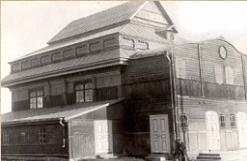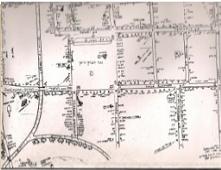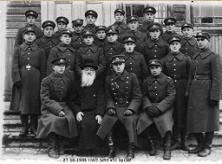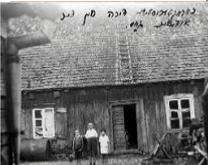Recollections
The Vilkaviskis that we remember - a talk with Mr. and Mrs. Oppenheim of Netanya, Israel.
Mr. Oppenheim moved with his family to Vilkaviskis when he was
six years old, around 1923. He lived there with his wife [Mrs. Oppenheim came from Suwalki] until 1941.
"The Great Synagogue was built, a guess, around 300 years ago, I think with money donated from a Lithuanian princess. It was a very impressive building built entirely from wood; it had very high ceilings and of course balconies where the women sat. The Great Synagogue was only used on Fridays, Saturdays, and holidays. During the week the Beit Midrash was used, and in the town there were at least five "smaller" synagogues.
The Rabbi and the Cantor were paid for by the "Yad Hakehila." For instance, my father was a butcher, and for every animal slaughtered by the shochet [who was also an employee of the Kehila], a tax was paid to the Yad.
Now the smaller synagogues, which represented the different "streams" of thought - there was, for example, a German synagogue, a Hassidic synagogue and a "medium" synagogue. Here the rabbis were usually the most distinguished and the most highly regarded members of each community. The Beit Midrash was open every day and it was of course used for study.
The Old Peoples' Home was another very impressive building. It had been built with money sent by Vilkaviskis citizens who had in many cases settled in the United States. My friends and I would visit the Old Peoples' Home every week, for because the members prayed, we went to establish a Minyan. I remember being called in by the bookkeeper and he showing me the many entries of money that had been donated by my family who had emigrated to the United States. If I remember correctly, there were around 30 - 40 rooms in the Old Peoples' Home - it was one of the few buildings not burnt down, and I have heard that today it is used as a small hospital.
So altogether the Jewish Community paid the wages of the Rabbi and the Cantor of the Great Synagogue, of the ritual slaughterer and of the Hevra Kaddisha. I remember that besides the ritual slaughterer, there was a Lithuanian veterinarian who came to check the quality of the meat that was being sold.
Besides this, there was also the "Jewish Community Bank" where money was loaned to those in need.
The Mikva was a part of the Jewish Public Baths, where we would go once every couple of weeks - it had steam baths as well as a sauna.
I guess that there was "politics" as you will find everywhere, and I remember my family having a falling out with the Hevra Kaddisha.
There was a private Jewish kindergarten in Vilkaviskis where children could be sent at the age of four. Before this age children were at home. At six years old children could go either to the Lithuanian Primary School or the Jewish Primary School - and I remember that one family sent its six-year-old children away to a Yeshiva! So you can see the range of beliefs was very varied. For high school education again there were several options: Some parents preferred to send their children to the Lithuanian High School; the advantage here was that [1] graduates from this school achieved a much higher standard in Lithuanian and with this it was easier to get into the university in Lithuania, and [2] it was much cheaper than the Jewish high schools.
There were two Jewish high schools: the Gymnasium - here the standard of formal education was high and graduating from the Gymnasium was recognized all over the world; and an ORT Trade School which was in the same building. The money for this school was again donated by Vilkaviskites who had moved overseas. I realized that this school was more suitable for me, and here I studied to be a motor mechanic. This profession was later to save my life.
The major improvements to life in Vilkaviskis were made during the First World War when Vilkaviskis was occupied by the Germans. During this period both electricity was provided and the sewage system was installed. After the First World War when Lithuania became an independent Republic, a program of land reform was introduced; large estates were broken up and land was distributed to anyone who requested it.
Around Vilkaviskis there were several Jewish farmers who grew both wheat and vegetables. There was also a Jew named Kop who would collect and process the milk from the local Lithuanian farmers. Although none of the Jews in Vilkaviskis owned orchards, there were many orchards in the area and in many cases Jewish contractors would buy the crop on the trees.
I remember and miss so very much the wonderful fruits that grew around Vilkaviskis - the apples, plums, pears, strawberries, gooseberries, blackberries, and currants. We would pick the fruit, bottle it and of course make wonderful jams. All this produce would be kept in our cellar, which of course was very cool. Our house, which was really quite small, had two bedrooms and a kitchen. I remember that in the kitchen there was a stove that we used for baking, and it took up half the room. Outside we had a small garden.
In Vilkaviskis there were two large factories, one for making soda water and the second for making brushes from pig bristles. Besides this there were many small traders - shoemakers, a shop that sold crockery [imported from Czechoslovakia], an electrical goods store, a bike shop, bakeries, and of course butchers. There were tailors and seamstresses. Grocery shops sold "dry goods;" they sold sugar, flour spices, etc., sold by weight and then wrapped in paper.
Twice a week a market was held on Mondays and Thursdays. There was a hotel where the farmers would tie up their wagons whilst the market took place. Here the farmers would come from the surrounding areas and sell their produce. Here we bought butter and eggs and often chickens. The Jewish tailors and seamstresses sold the clothes they made also at these markets. There were also small traveling markets that would visit the more outlying villages.
The bristle factory was a very large enterprise, and I would like to tell you a story that may give you a better understanding of life in Vilkaviskis. During the time that Vilkaviskis was part of the Russian Empire [prior to 1917] there were Communist agitators at the factory. My uncles worked at the factory. There came Russian police to arrest the agitators and my uncle was arrested. At that time the prisoners were sent on foot to Siberia.
One year after he was arrested, my uncle managed to escape and returned to Vilkaviskis. My family knew that he was a "wanted man" and sent him to Germany. From there he was able to make his way to the United States. Later his brother was also arrested but he managed to escape on his way east. At a stop he asked one of the soldiers guarding him to give him a moment to go and a buy a cigarette. He told the guard that he would bring the soldier a cigarette as well. The soldier released him and he used the opportunity to escape and return to Vilkaviskis.
Here again his family smuggled him over the border into Germany, and from there he was able to get to the United States. We knew that with two brothers having escaped, the Russian authorities would soon come for the youngest brother - so they again smuggled him over the border and he too made his way to the United States.
We believe that my uncles were "informed on" when after the First World War they returned to Vilkaviskis for a visit; they wanted to thank the "collaborators" for giving them the opportunity to reach the United States.Ó
